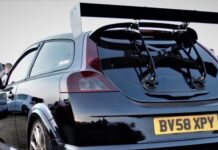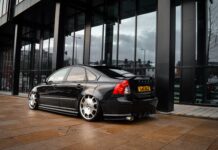Having owned multiple S40s, V50s, and C30s over the years, I often consider my modified P1 Volvos to be mutts within the automotive community. As anyone who has modified a Volvo will know, limited aftermarket support often requires that the owners get creative when seeking upgrades. Half of the parts on my suspension are stamped with FoMoCo (Ford Motor Company). I have Mazda Speed 3 front calipers with Focus ST front rotors and Jaguar Super V8 rotors in the rear. My 5×108 bolt pattern wheels are a direct fit on some Ferraris. My end links are from a Honda Pilot. I have a Mustang GT500 hood vent and coolant reservoir. So why not include a Porsche part into the mix?
As it turns out, the 2002-2005 Porsche 911 throttle body (part number: 98660511501) is a direct bolt-on replacement for the original Volvo unit. Plug and play, no software is needed.
The 65mm Volvo throttle body is more than sufficient for a stock T5 engine, but with an upgraded intake manifold and larger intercooler piping, the stock throttle body becomes a bottleneck in the system.
Despite the Porsche throttle body only being 70mm in diameter, that is still a 13% greater surface area for air to flow through. The images below shows the Porsche throttle body (left) compared to the Volvo throttle body (right).


Though the Porsche throttle body has a slightly smaller lip for the intercooler hose to connect, there is still sufficient room to fit the hose and band clamp. If reusing the stock rubber hose, then you will need to heat and stretch it to fit around the inlet of the Porsche unit; most aftermarket silicone hoses are large enough to fit on with a little massaging. I can confirm that both the stock rubber hose and the Elevate hose will fit after some coaxing; the trick is to be patient and make sure the hose is seated evenly to the throttle body before tightening down the band clamp.
Extended screws will also be required for installation of the Porsche unit. Some aftermarket intake manifolds make use of different screw threading, so double check your threading prior to purchasing the screws. The Elevate and PumaSpeed intake manifold both require M6x1.0 threading, 50mm in length.
Removal of the stock throttle body is fairly straightforward.
Step 1. Disconnect the battery and do NOT reconnect it or attempt to start the vehicle until the throttle body is reinstalled and secured in place. While you may be tempted to turn the car on without starting the engine, to test the throttle body before installation, know that this may result in a check engine light and error.
Step 2. Remove the band clamp and slide the intercooler hose off.


Step 3. Remove the four bolts or screws that hold the throttle body to the intake manifold. A small ratcheting wrench with the appropriate bit makes access to the rear screws much easier.

Step 4. Disconnect the wiring connector to the throttle body by depressing the tab and separating both halves of the connector.

Step 5. Remove the throttle body from the car.

To install the new throttle body, just follow the removal instructions in reverse order. Remember to be patient with stretching the intercooler hose to fit over the larger diameter throttle body inlet. Some people find it easier to disconnect the hose from the intercooler and mount it to the throttle body while it is off of the car.
Around town, the 5mm larger throttle body does not give any noticeable improvements. But launch the car or rapidly accelerate near wide open throttle and the car takes off quicker, pulling stronger. With a larger throttle body, more air is being released into the intake manifold. This is great when paired with aftermarket manifolds which are designed to optimize air flow into the engine. However, the stock manifold still hinders that flow, so an upgraded throttle body may not show any improvements on an otherwise stock setup.
As previously mentioned, the 70mm diameter Porsche throttle body has a 13% wider opening at wide open throttle. Simple math would suggest that when the Porsche throttle body is 87% open, it would equate to the same airflow of the stock throttle body when opened at 100%. Therefore, on an otherwise stock setup, when the Porsche throttle body is opened to 87%, it has reached the manifold’s maximum airflow capacity and the remaining 13% will make no difference in the performance of the vehicle. So what can be concluded? With the Porsche throttle body installed, less pedal depression is required to reach peak performance. In a back to back comparison with equal pedal depression, a larger throttle body will make the car feel faster off the line.
So why buy this 70mm throttle body when software can remap the factory throttle for similar results? Side note: the factory throttle mapping is non-linear, resulting in a less than ideal power delivery for performance driving.
The main reason why I suggest upgrading to a 70mm throttle body is to eliminate the bottleneck. Most aftermarket intake manifolds have a 70mm inlet, so installing a 70mm throttle body provides a seamless transition and while the measurable improvements are miniscule, the airflow should be smoother.
Would installing the Porsche throttle body and having my throttle remapped with software compound the effect? Yes.
Would this create an overly aggressive throttle response? That is entirely dependent upon your personal preference. Some say yes, some say no.
Do I need to retune my car for a bigger throttle body? No. The only reason to update your tune file would be if you found the throttle response to be too aggressive and wish to tone it down without sacrificing the performance benefits.
Will this sacrifice my fuel economy? If you drive the car with the same level of gas pedal input upon acceleration as previously applied, then you will notice a slight drop in your miles per gallon as the car adds more fuel to compensate for the additional air. Otherwise, there will be no negative side effects to the vehicle’s fuel efficiency.
Will I see improvements on the dyno? No. The dyno measures performance at wide open throttle and your car’s cubic-feet-per-minute consumption of air flow is limited by more than just the throttle body. Installing a larger throttle body improves the response and feel from a driver’s perspective, which can only be measured on your personal butt dyno.
Will a bigger throttle body improve my 0-60 time? Technically, yes, because it is allowing more air into the engine milliseconds faster than the stock throttle body. But this tiny improvement may only save you a few hundredths of a second. This same statement can be made for software and devices that remap throttle response.
If the Porsche throttle body is not an option for you or you simply do not want to “waste” your money on a part that does not add horsepower, I would still highly suggest using these removal instructions for a routine throttle body cleaning. The CRC Throttle Body & Air Intake Cleaner does wonders for removing dirt and grime stuck to the butterfly valve. Even just cleaning the throttle body every sixty thousand miles can salvage a few horse powers that may have been lost with time.









